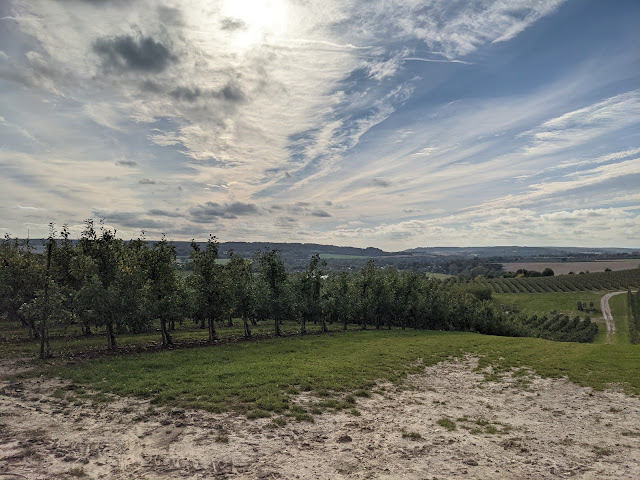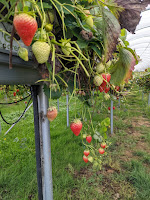I went to visit my friend Leon in Canterbury today, and rather than remaining in the city for the duration, we thought for a change it might be good to head out into the surrounding countryside for a walk. Canterbury is great like that - it's still a relatively condensed city, and you don't have to walk far in any one direction to be out into the green landscape which surrounds it.
Our route today roughly followed the North Downs Way, from Canterbury West station, to Chilham, although we deviated in places. We started with a visit to the Goods Shed, next to the station, to stock up on victuals - cheese and wine - for later on in the walk.
We headed out towards Harbledown, on the edge of Canterbury, and not long after setting off we were surrounded by green fields, gentle rolling hills, and orchards. Of course the orchards we saw today were mostly modern, commercial orchards, with shrub like trees arranged in neat rows, looking a bit like vineyards from a distance - but they were not unappealing to the eye, and with most appearing to have recently been harvested they gave a real sense of the season.
We also saw a few grape vines, but more on a a garden scale.
A little further along we passed through the grounds of the former Hospital of St. Nicholas Harbledown - "founded by Archbishop Lanfranc c 1084 for the relief of Lepers.". Beyond there, we had a quick refreshment stop at the Old Coach and Horses in Harbledown, which I neglected to take a photo of.
From there we continued on Leon's diversion from the North Downs Way, following the road for a little way past Kent College Junior School, then into the woods - part of a wider area of woodland called Blean Woods, with this particular section possibly being Bigbury Woods, the site of the Bigbury Camp. Leon mentioned that "wild" goats roamed these woods to help keep the vegetation down, and there was even talk in a nearby woodland of re-introducing European Bison for a similar purpose.
This section of the walk (along with some later sections) turned out to be excellent territory for hunting chestnuts, and in places the path seemed to be completely strewn with them, with many of the casings open, some of the chestnuts of reasonable size, and in fairly good condition - I think we'd timed it just right from that point of view. I also spotted a few mushrooms which I believe to be amethyst deceivers. Again I was a bit remiss at taking photos.
A little further into the woods we passed by No Man's Orchard, apparently a community owned orchard, which made for a nice contrast to the more intensively farmed orchards we'd seen for much of today. Here the trees were very spaced out and allowed to grow naturally, and seemingly a popular spot for locals to sit and enjoy.
Towards the far end of the woods, near Chartham Hatch, we passed by an area Leon said had originally been a deer park, and where they now seemed to keep donkeys (and at least one deer still).
Beyonf Chartham Hatch, we got into fairly serious commercial fruit growing land once again, passing by huge polytunnels filled with strawberries - the smell was quite incredible.
Then more orchards, sprawling as far as the eye could see.
We came to a bench - "Roger's Rest" - beside the orchards, and Leon suggested it would be a nice spot to stop for some cheese and wine. I didn't manage to get a very good photo of the cheese - mainly just Leon cutting it up - but it was very good indeed. One was
Ancient Ashmore, the other
Canterbury Cobble. The wine was Litmus Pinot Noir, apparently made with Kentish grapes - which seemed approrpriate - albeit that the actual winemaking happened in Surrey. It's been a while since I've had an English still red, and I had to re-acquaint myself with how light it is after Burgundy, but it was fairly pleasant - youthful, slightly floral and went really well with the cheese as the chap who sold it to us said it would.



After what I suppose was technically lunch, we continued on through more fields and orchards, and eventually rejoined the North Downs Way to take us into the curiously named village of Old Wives Lees. Although it looks like there may have been a pub there (we couldn't quite tell from a distance whether it was open) we carried on through, and headed in the direction of Chilham.
Chilham is a very pretty village, centred on a very picturesque square (which would look nicer still if it didn't have a load of cars parked in the middle). Leon mentioned it had been used as a filming location in various period dramas, and as such we encountered a few American tourists while we were there.
Chilham Castle occupies one side of the square, looking suitably grand and imposing, and was apparently up for sale earlier this year.
Leon and I, however, were a bit more interested in the opposite side of the square, where stood the rather handsome looking White Horse. Although the beer selection was a little underwhelming (I seemed to be having an unlucky day in that regard - in both pubs we visited the bitter was off, leaving only dreaded IPAs on the hand pumps) the quick glimpse I had of the interior also passed muster, including a large open fire, which didn't seem entirely warranted given the surprisingly warm weather today.

We took the train back from Chilham to Canterbury, and rounded off the day with a final drink at the Millers Arms, not too far from the station, just about catching the tail end of the sunset.































Comments
Post a Comment